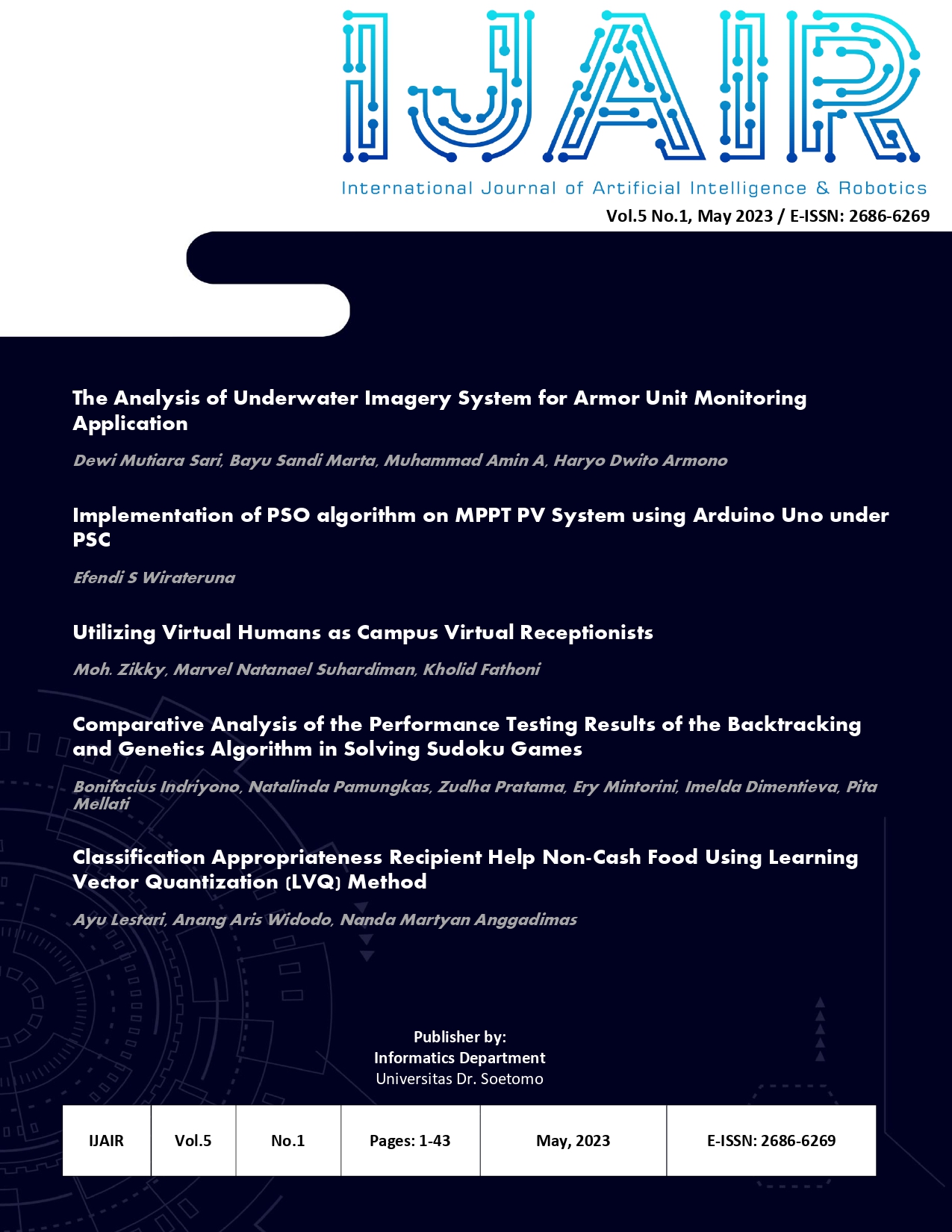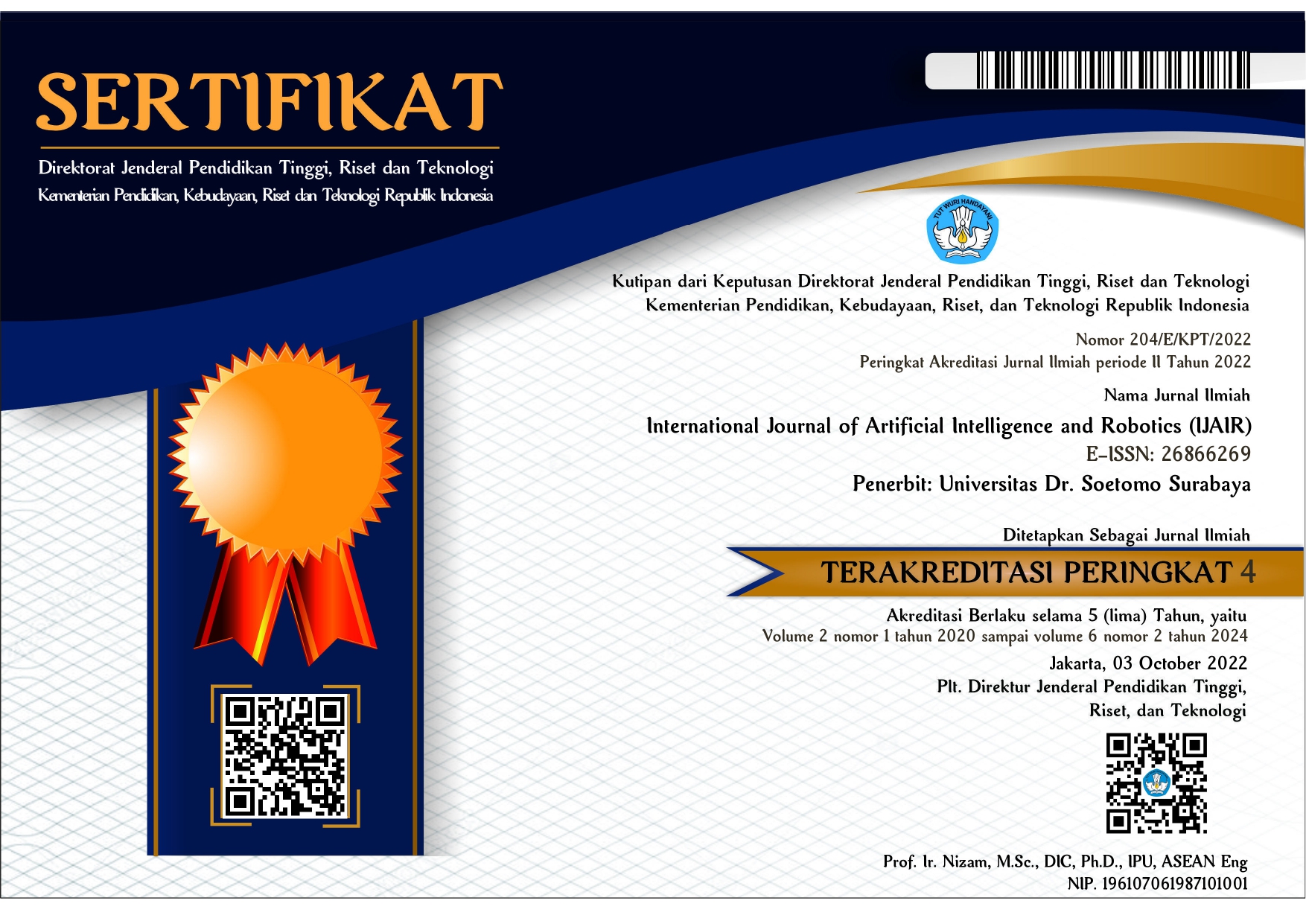Utilizing Virtual Humans as Campus Virtual Receptionists
 Abstract views: 425
,
Abstract views: 425
,
 PDF downloads: 313
PDF downloads: 313
Abstract
To imitate human-like behavior is one of the greatest feats a computer software could achieve. Computers can produce close-to-realism avatars with similar looks and behaviors in this modern era. One of the works that computer software could achieve now is conveying information in a place that a receptionist usually does. Therefore a computer software capable of that is called a Virtual Receptionist. This paper aims to explore the use of virtual humans as virtual receptionists and compare it to human receptionists to find both advantages and disadvantages. This research utilizes a virtual human model that imitates the behavior of a human receptionist. Its movements are based on real-life movements recorded with motion capture. It could also communicate with users by processing the voice input using speech-to-text technology recorded by a microphone. The recorded input will then be analyzed to determine whether it contains information stored in a database. The virtual human will then show the user the answer to their question accordingly. Utilizing virtual humans can make the process more interactive and exciting because of its futuristic feel. This way, campuses can have appealing introductory media and support campuses to be more open to the public in the future. However, the agent can only respond with prepared answers and not generate its own when necessary. Transcribed text will be analyzed for words that indicate the user's required information. In this case, the information would be the information of research laboratories in the post-graduate building of the EEPIS campus.
Downloads
References
Zikky, M., Yuniar Hakkun, R., & Rafsanjani, B. (2019). Indonesian Sign Language API (OpenSIBI API) as The Gateway Services for Myo Armband. International Journal of Artificial Intelligence & Robotics (IJAIR), 1(1), 16-25. doi: 10.25139/ijair.v1i1.2026.
Garrido, Piedad & Martinez, Francisco & Guetl, Christian. (2010). Adding Semantic Web Knowledge to Intelligent Personal Assistant Agents. CEUR Workshop Proceedings. 687.
Zikky, Mohammad & Basuki, Achmad & Ardiyanto, Mohamad Heru, INTERACTIVE AGENT TOUR GUIDE IN EEPIS VIRTUAL CAMPUS TOUR WITH VOICE COMMAND (2018)
Sagar, Mark & Seymour, Mike & Henderson, Annette. (2016). Creating connection with autonomous facial Animation. Communications of the ACM. 59. 82-91. 10.1145/2950041
Gadia, Davide & Celata, Tommaso & Notarangelo, Antonio & Ripamonti, Laura & Maggiorini, Dario. (2018). G.E.M.I.X.: Game Engine Movie Interaction eXperience.
Srinivisa, Arul, Madheswari, A. Neela, The Role of Smart Personal Assistant for improving personal Healthcare, International Journal of Advanced Engineering, Management and Science (IJAEMS) [Vol-4, Issue-11, Nov-2018], https://dx.doi.org/10.22161/ijaems.4.11.5
Unismuh, Junaid. (2020). The Verbal Interaction Between Lecturers and Students in Classroom. 10.13140/RG.2.2.22728.34567.
Nogueira, P. (2011). Motion Capture Fundamentals: A Critical and Comparative Analysis on Real-World Applications. Faculdade de Engenharia da Universidade do Porto. Programa Doutoral em Engenharia Informática. Instituto de Telecomunicações. Retrieved from https://paginas.fe.up.pt/~prodei/dsie12/papers/paper_7.pdf
Nurindiyani, Artiarini & Pramadihanto, Dadet & Afifah, Rosyidina. (2019). Motion Modeling of Traditional Javanese Dance: Introduction of Javanese Dancer Gesture with 3D Models. 195-201. 10.1109/ELECSYM.2019.8901523.
Wu, Qingqiang & Xu, Guanghua & Li, Min & Longting, Chen & Zhang, Xin & Xie, Jun. (2018). Human Pose Estimation Method based on Single Depth Image. IET Computer Vision. 12. 10.1049/iet-cvi.2017.0536.
Naseer, Salman & Ghafoor, Muhammad & Sohaib, & Khalid Alvi, Sohaib & Kiran, Anam & Rehman, Shafique Ur & Murtaza, Ghulam & Campus, Jehlum & Jehlum, Pakistan. (2022). Named Entity Recognition (NER) in NLP Techniques, Tools Accuracy and Performance.
Aqlan, Ameen & Bairam, Dr. Manjula & Naik, R Lakshman. (2019). A Study of Sentiment Analysis: Concepts, Techniques, and Challenges. 10.1007/978-981-13-6459-4
Mahany, Ahmed, Heba Khaled, Nouh Sabri Elmitwally, Naif Aljohani, and Said Ghoniemy. 2022. "Negation and Speculation in NLP: A Survey, Corpora, Methods, and Applications" Applied Sciences 12, no. 10: 5209. https://doi.org/10.3390/app12105209
https://cloud.google.com/natural-language/pricing#pricing_units (Accessed March 2023)
Mehl, Matthias & Vazire, Simine & RamÃrez-Esparza, Nairán & Slatcher, Richard & Pennebaker, James. (2007). Are Women Really More Talkative Than Men?. Science (New York, N.Y.). 317. 82. 10.1126/science.1139940.
Copyright (c) 2023 Moh. Zikky, Marvel Natanael Suhardiman, Kholid Fathoni

This work is licensed under a Creative Commons Attribution-ShareAlike 4.0 International License.
Authors who publish with International Journal of Artificial Intelligence & Robotics (IJAIR) agree to the following terms:
-
Authors retain copyright and grant the journal right of first publication with the work simultaneously licensed under a Creative Commons Attribution License (CC BY-SA 4.0) that allows others to share the work with an acknowledgment of the work's authorship and initial publication in this journal.
-
Authors are able to enter into separate, additional contractual arrangements for the non-exclusive distribution of the journal's published version of the work (e.g., post it to an institutional repository or publish it in a book), with an acknowledgment of its initial publication in this journal.
-
Authors are permitted and encouraged to post their work online (e.g., in institutional repositories or on their website) prior to and during the submission process, as it can lead to productive exchanges, as well as earlier and greater citation of published work.















